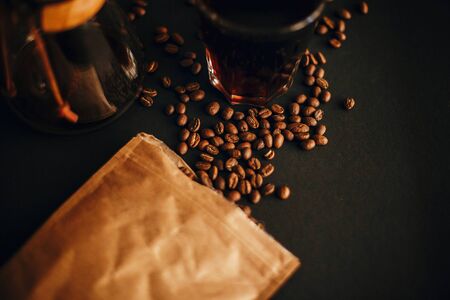1. Setting the Scene: Coffee Culture and Packaging in the UK
Step onto any British high street and you’ll notice that coffee has woven itself seamlessly into daily life, from bustling artisan cafés in London’s Soho to charming local roasteries scattered across the Cotswolds. This evolving coffee culture is as much about ritual as it is about taste—a comforting morning flat white, a quick espresso on the go, or an afternoon filter brew shared with friends. But beyond the aroma of freshly ground beans, there’s another element quietly shaping our experience: packaging. In Britain, where tradition meets innovation at every corner, the materials we choose for coffee packaging tell a story all their own. From classic paper bags and sturdy cardboard boxes to sleek new-age alternatives, each choice sets the tone for how we perceive quality, sustainability, and even the simple pleasure of opening a fresh bag of beans. As coffee habits evolve and expectations rise, the conversation around packaging becomes not just about practicality but also about reflecting our cultural identity—blending time-honoured British sensibilities with modern demands for eco-friendliness and design flair.
2. Paper and Cardboard: Tried-and-Trusted Favourites
When you stroll down the high street or pop into an independent coffee house in Britain, chances are youll spot bags and boxes crafted from paper or cardboard. These materials have been stalwarts of British coffee packaging for generations, not just for their practical merits but also for their deep-rooted cultural resonance. Let’s take a closer look at why they continue to capture both the hearts and minds of roasters and consumers alike.
Heritage: A Nod to British Tradition
The history of paper and cardboard packaging in the UK is intertwined with the country’s industrial progress and love for design simplicity. From traditional brown paper bags at historic grocers to the crisp white board boxes at upmarket retailers, these materials have long embodied a classic, no-nonsense British approach—practical, reliable, and reassuringly familiar.
Sustainability: Leading the Green Charge
With sustainability now top-of-mind for many Britons, paper and cardboard are firmly in the limelight. Not only are they renewable and biodegradable, but advances in recycling technology mean today’s packaging often comes with impressive eco-credentials. Many coffee brands proudly display their FSC certifications or recycled content percentages right on the box, reinforcing a commitment to environmental stewardship.
| Material | Renewable? | Biodegradable? | Recyclable? | Cultural Appeal |
|---|---|---|---|---|
| Paper | Yes | Yes | Yes | Timeless, understated elegance |
| Cardboard | Yes | Yes | Yes | Sturdy, practical, quintessentially British |
Cultural Appeal: More Than Just Packaging
For many UK coffee lovers, there’s something nostalgic about unboxing a fresh bag sealed with a simple paper label or running fingers over textured cardboard. The tactile quality of these materials evokes memories of local markets, village shops, and proper British craftsmanship. In a world increasingly dominated by digital experiences and synthetic finishes, paper and cardboard offer a tangible connection to heritage—a sense of place rooted in tradition yet evolving with modern sensibilities.
![]()
3. Emergence of Modern Materials
The landscape of coffee packaging has seen a remarkable transformation in recent years, marked by the rise of modern materials that go far beyond the simplicity of paper and cardboard. In today’s eco-conscious Britain, there is a keen interest in finding solutions that not only preserve the freshness of our beloved brews but also tread lightly on the environment. Let’s delve into how plastics, compostables, and innovative composites are shaping the future of coffee packaging.
Plastics: Convenience Meets Criticism
Plastic has long been celebrated for its ability to provide an airtight seal, keeping coffee beans and grounds fresh for longer. Flexible pouches with resealable zips are now commonplace on supermarket shelves from Bristol to Edinburgh. However, while plastic offers undeniable practicality and moisture resistance, it has come under scrutiny for its environmental impact—particularly single-use variants that contribute to landfill waste and ocean pollution. Across the UK, calls for increased recycling infrastructure and reduction of virgin plastics echo through both urban cafés and rural roasteries alike.
Compostable Solutions: Green Credentials on Display
In response to growing sustainability demands, many British brands are championing compostable packaging. Made from plant-based materials such as cornstarch or cellulose, these alternatives break down naturally in industrial composting facilities. For independent roasters in places like Brighton or Manchester, compostables offer an opportunity to align their packaging with ethical sourcing and eco-friendly values. It’s a nod to localism and a greener future—yet challenges remain, such as ensuring access to appropriate composting facilities for end users.
Innovative Composites: The Best of Both Worlds?
To bridge the gap between performance and planet-friendliness, composite materials are gaining traction across the UK coffee scene. These hybrid solutions often layer paper or cardboard with thin bioplastic coatings or recycled foil linings, offering both barrier protection and partial recyclability. Not only do they aim to reduce overall plastic content, but they also reflect a certain British ingenuity—blending tradition with innovation in pursuit of better-tasting coffee and a cleaner conscience.
Navigating Choices in Modern Packaging
The emergence of modern materials means today’s roasters and retailers must weigh up freshness, appearance, cost, and environmental impact—a balancing act that typifies the ongoing evolution of British taste and sensibility. Whether popping into a local London café or picking up beans at your village market stall, you’re likely to encounter packaging that tells a story—not just about coffee origins but about our collective responsibility towards sustainable living.
4. Sustainability and Local Responsiveness
When it comes to coffee packaging in the UK, the debate between traditional and modern materials is increasingly shaped by sustainability imperatives and local sensibilities. Environmental concerns now sit firmly at the top of the agenda for both brands and consumers. The choice between paper, cardboard, plastics, and innovative composites isnt just about aesthetics or cost—its a reflection of our commitment to the planet.
Environmental Concerns: A British Perspective
The UK is facing mounting pressure to reduce waste and carbon emissions. Traditional materials such as paper and cardboard are often perceived as more eco-friendly, thanks to their biodegradability and established recycling infrastructure. However, modern materials can offer lighter weights and extended shelf life, potentially reducing food waste—a key issue in British households.
Recycling Rates: How Do Materials Stack Up?
| Material | Recyclability (UK) | Carbon Footprint | Common Challenges |
|---|---|---|---|
| Paper | High (over 80%) | Low-Moderate | Moisture sensitivity, limited barrier properties |
| Cardboard | High (around 85%) | Moderate | Bulky, may require coatings that hinder recycling |
| Plastics (Modern Composites) | Low-Moderate (20-40%) | Varies (often lower weight per unit) | Difficult to recycle, lack of nationwide facilities |
| Bioplastics & Innovatives | Emerging (facility-dependent) | Potentially low, but production impacts vary | Lack of clarity for consumers, infrastructure gaps |
The UKs Unique Challenges & Innovations
The British approach to sustainable packaging is defined by both regulation and innovation. Recent government initiatives encourage businesses to adopt recyclable and compostable options, while local councils invest in better sorting technologies. Yet, the patchwork nature of recycling facilities across regions creates confusion for consumers—whats recyclable in London might not be in Leeds.
Pioneering Solutions on Home Soil
Boutique roasters and major chains alike are experimenting with locally-sourced recycled fibres and plant-based laminates. Some have even partnered with British universities to develop next-generation barrier coatings that promise full recyclability without sacrificing freshness. These moves are not just good PR—they reflect a distinctly British ethos: practical solutions that marry tradition with forward-thinking design.
5. Aesthetic and Consumer Perception
In the UK, where a morning brew is more than just a beverage—it’s a cherished ritual—the look and feel of coffee packaging carry significant weight. Packaging materials, whether traditional like paper and cardboard or innovative composites, play a crucial role in shaping not only brand perception but also the everyday ‘coffee moment’ for British consumers.
The Power of First Impressions
For many Brits, that first encounter with a bag of coffee on the shelf is visual and tactile. Paper and cardboard, with their familiar textures and sustainable credentials, evoke a sense of authenticity and nostalgia. These materials often signal craft, care, and a nod to heritage—qualities that resonate deeply within the UK’s culture of understated sophistication. In contrast, modern materials such as aluminium-lined plastics or compostable films often project innovation, freshness, and even luxury.
Brand Storytelling Through Materials
British brands keen on conveying artisanal values or environmental responsibility frequently opt for uncoated kraft paper or recycled board. Such choices speak volumes about a roaster’s ethos before the coffee is even brewed. Meanwhile, contemporary brands targeting younger demographics may lean into sleek laminates or bold metallic finishes to signify energy and modernity. In this way, the material becomes part of the story—a silent ambassador of brand identity.
The All-Important ‘Coffee Moment’
Ultimately, packaging shapes the experience of that quintessential British coffee break. The satisfying crinkle of brown paper or the reassuring sturdiness of cardboard can enhance anticipation, making the act of opening a new bag feel special. Conversely, modern resealable pouches or airtight tins reflect evolving expectations for convenience and freshness—essentials for today’s fast-paced lifestyles. Thus, packaging material isn’t just functional; it’s integral to how British consumers perceive quality, trustworthiness, and even the simple pleasure of their daily cup.
6. Blending Old and New for the Future
As we look to the future of coffee packaging in the UK, it becomes clear that the real magic lies in blending traditional and modern materials. Paper and cardboard have long been stalwarts, embodying a sense of nostalgia and tactile warmth, while innovative solutions like compostable bioplastics or smart packaging are reshaping our expectations for sustainability and convenience. Rather than viewing these approaches as mutually exclusive, forward-thinking British brands are finding creative ways to harmonise them—retaining the charm and authenticity of classic paper-based designs while embracing new technologies that reduce environmental impact. This fusion mirrors the broader evolution of British coffee culture itself: rooted in heritage but always eager to experiment and evolve. By balancing tradition with innovation, UK coffee businesses can cater to both eco-conscious consumers and those who value a sense of craftsmanship. The next wave of coffee packaging isn’t about choosing sides; it’s about crafting a uniquely British identity that respects the past while boldly stepping into tomorrow.

